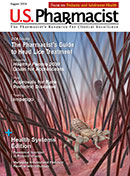Emergency-Use Authorizations
Since the severe acute respiratory syndrome coronavirus 2 (SARS-CoV-2) infection and the resulting coronavirus disease 2019 (COVID-19) emerged in late 2019, millions of people globally have become infected and suffered serious complications or died. COVID-19 vaccine development started in January 2020, when the SARS-CoV-2 genetic sequence was released by the CDC and disseminated globally by the Global Initiative on Sharing All Influenza Data. Recently, two vaccines for COVID-19 from Pfizer-BioNTech and Moderna received emergency-use authorization in the United States. With the distribution of vaccines across the country, many have approached their local pharmacist with questions about the administration, dosing, side effects, and efficacy of the available options.
Novel Mechanisms of Action
The SARS-CoV-2 virus has a protein that protrudes from the surface like a “spike.” This protein is the method by which the virus attaches itself to our cells. Early in the pandemic, scientists were able to identify the genomic structure of the protein spike. The vaccine delivers the mRNA of the spike protein to the body, and the body, in turn, develops antibodies against the spike protein of the SARS-CoV-2 virus. Thus, when the body next comes into contact with the virus, these antibodies should attack the virus protein spike, making it unable to attach and infect cells.
Like the COVID-19 vaccines available today, mRNA-based vaccines do not contain a live virus or even denatured DNA of the full virus. Only the mRNA for the protein spike is included in the vaccine. It is not possible to contract COVID-19 from the vaccine itself. The Pfizer-BioNTech and Moderna COVID-19 vaccines demonstrated a 94% to 95% efficacy rate for preventing infection. Both show early evidence of lowered disease severity if one becomes infected after vaccination. Because of the sensitive nature of the mRNA, both formulations require cold storage and freezing for distribution. For specific instructions on storage requirements, consult the product packaging.
CDC Vaccine-Distribution Recommendations
The CDC has issued recommendations for allocating the vaccine in the U.S., starting with healthcare workers and long-term-care facility residents. Ultimately, all people over the age of 16 years and without contraindications will be encouraged to become vaccinated.
Not everyone is a candidate for vaccination. Contraindications for vaccination include anyone with a previous severe or immediate allergic reaction to a COVID-19 mRNA vaccine dose, a vaccine component, or polysorbate; those younger than age 16 years; and people currently isolating or experiencing symptoms of COVID-19 (these individuals can get vaccinated once they have finished isolating and their primary symptoms have resolved). Consultation with a physician is recommended before vaccination if the individual has a history of a severe or immediate allergic reaction to any vaccine or injectable medication; is pregnant; has certain immune-compromising conditions; or is breastfeeding or taking anticoagulants.
Two Doses Are Required
Both vaccines require two doses, given 3 to 4 weeks apart depending on the formulation. It is important to receive both doses of the vaccine to achieve the appropriate protection against infection with SARS-CoV-2. The most common side effects of both vaccines include mild-to-moderate pain at the injection site, as well as fatigue, body aches, and headaches. Side effects most commonly occur after the second dose is given. Long-term side effects from either formulation have yet to be determined. Studies for both vaccine formulations are ongoing to assess longer term efficacy and safety.
It is still recommended that a mask be worn after COVID-19 vaccination. The vaccine is not 100% effective, meaning it will not work for everyone, so even if you received the vaccine, there is a small chance you can become infected. Also, it is unknown whether those who are vaccinated might still be able to spread the virus, even if they do not become infected themselves.
The content contained in this article is for informational purposes only. The content is not intended to be a substitute for professional advice. Reliance on any information provided in this article is solely at your own risk.
To comment on this article, contact rdavidson@uspharmacist.com.






